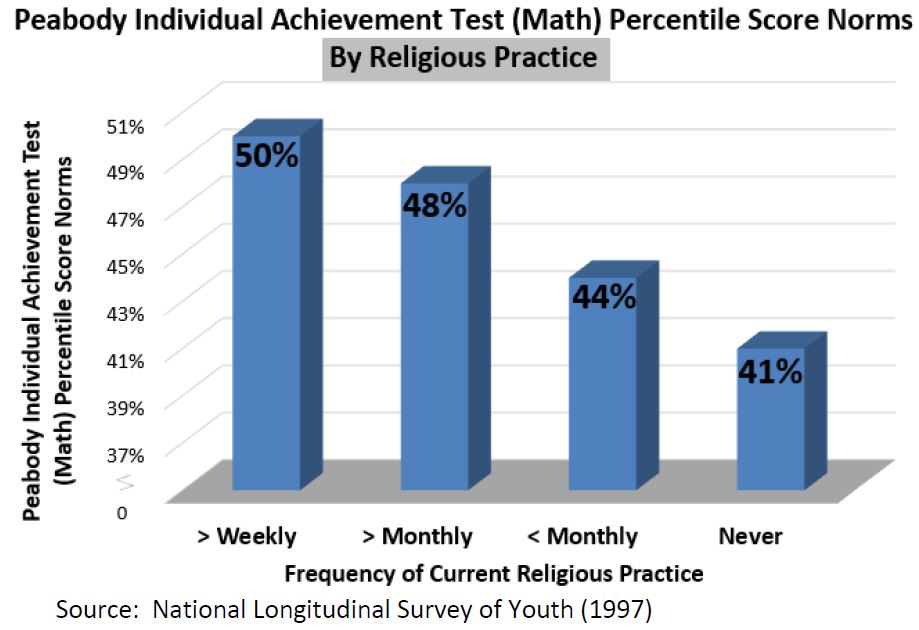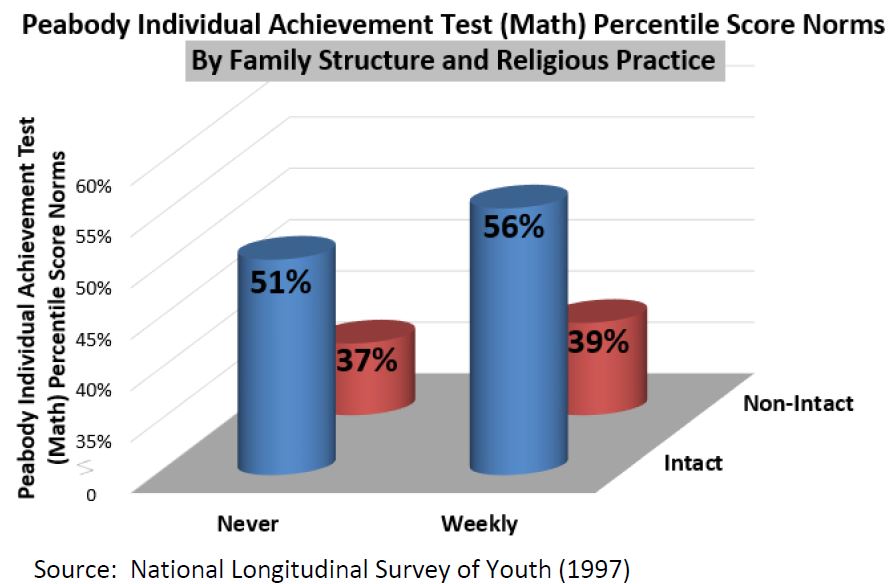Click Here to download “Peabody Individual Achievement Test (Math) Percentile Score by Family Structure and Religious Practice”
Peabody Individual Achievement Test (Math) Percentile Score by Family Structure and Religious Practice
The 1997 National Longitudinal Survey of Youth shows that students who grew up in an intact married family and worshipped at least weekly had higher math scores on the Peabody Individual Achievement Test, an academic aptitude test administered to students in grades K-12.
[1]
Family Structure: Students from married, always-intact families scored in the 54
th percentile on the math section of the PIAT. Students from married stepfamilies scored in the 44
th percentile, and students from divorced, single-parent families scored in the 42
nd percentile. Thereafter, scores experienced a steep drop-off: students in intact cohabiting families scored in the 32
nd percentile, and students in cohabiting stepfamilies and in always-single parent families scored in the 27
th percentile.
 Religious Practice:
Religious Practice: Students who attended religious services at least weekly scored in the 50
th percentile on the math section of the PIAT. Students who attended at least monthly scored in the 48
th percentile, students who attended less than monthly scored in the 44
th percentile, and students who never attended scored in the 41
st percentile.
 Family Structure and Religious Practice Combined:
Family Structure and Religious Practice Combined: Students from always-intact married families who attended religious services at least weekly scored in the 56
th percentile on the math section of the PIAT. Students from always-intact married families who never attended religious services scored in the 51
st percentile. Students from all other family structures had drastically lower scores: students from all other family structures who attended religious services at least weekly scored in the 39
th percentile, and students from all other family structures who never attended religious services scored in the 37
th percentile.
 Related Insights from Other Studies:
Related Insights from Other Studies: A study by Professor William H. Jeynes of California State University, Long Beach, found that “the influence of parental involvement overall [was] significant for secondary school children. Parental involvement as a whole affect[ed] all the academic variables under study.” The academic variables included in the study were: standardized tests, grades, teacher ratings, “academic attitudes and behaviors,” and a general measure for academic achievement. Parental involvement affected both white and minority children.
[2] Furthermore, a study of rural adolescents found that students who reported greater religious attendance had higher grades.
[3]
[1] These charts draw on data collected by the National Longitudinal Survey of Youth (1997).
[2] William H. Jenyes, “The Effects of Black and Hispanic 12th Graders Living in Intact Families and being Religious on their Academic Achievement,”
Urban Education 38.1 (2003): 35.
[3] Alyssa S. Milot and Alison Bryant Ludden, “The Effects of Religion and Gender on Well-being, Substance use, and Academic Engagement among Rural Adolescents,”
Youth & Society 40.3 (2009): 413.
]]>
 Religious Practice: Students who attended religious services at least weekly scored in the 50th percentile on the math section of the PIAT. Students who attended at least monthly scored in the 48th percentile, students who attended less than monthly scored in the 44th percentile, and students who never attended scored in the 41st percentile.
Religious Practice: Students who attended religious services at least weekly scored in the 50th percentile on the math section of the PIAT. Students who attended at least monthly scored in the 48th percentile, students who attended less than monthly scored in the 44th percentile, and students who never attended scored in the 41st percentile.
 Family Structure and Religious Practice Combined: Students from always-intact married families who attended religious services at least weekly scored in the 56th percentile on the math section of the PIAT. Students from always-intact married families who never attended religious services scored in the 51st percentile. Students from all other family structures had drastically lower scores: students from all other family structures who attended religious services at least weekly scored in the 39th percentile, and students from all other family structures who never attended religious services scored in the 37th percentile.
Family Structure and Religious Practice Combined: Students from always-intact married families who attended religious services at least weekly scored in the 56th percentile on the math section of the PIAT. Students from always-intact married families who never attended religious services scored in the 51st percentile. Students from all other family structures had drastically lower scores: students from all other family structures who attended religious services at least weekly scored in the 39th percentile, and students from all other family structures who never attended religious services scored in the 37th percentile.
 Related Insights from Other Studies: A study by Professor William H. Jeynes of California State University, Long Beach, found that “the influence of parental involvement overall [was] significant for secondary school children. Parental involvement as a whole affect[ed] all the academic variables under study.” The academic variables included in the study were: standardized tests, grades, teacher ratings, “academic attitudes and behaviors,” and a general measure for academic achievement. Parental involvement affected both white and minority children.[2] Furthermore, a study of rural adolescents found that students who reported greater religious attendance had higher grades.[3]
[1] These charts draw on data collected by the National Longitudinal Survey of Youth (1997).
[2] William H. Jenyes, “The Effects of Black and Hispanic 12th Graders Living in Intact Families and being Religious on their Academic Achievement,” Urban Education 38.1 (2003): 35.
[3] Alyssa S. Milot and Alison Bryant Ludden, “The Effects of Religion and Gender on Well-being, Substance use, and Academic Engagement among Rural Adolescents,” Youth & Society 40.3 (2009): 413.
]]>
Related Insights from Other Studies: A study by Professor William H. Jeynes of California State University, Long Beach, found that “the influence of parental involvement overall [was] significant for secondary school children. Parental involvement as a whole affect[ed] all the academic variables under study.” The academic variables included in the study were: standardized tests, grades, teacher ratings, “academic attitudes and behaviors,” and a general measure for academic achievement. Parental involvement affected both white and minority children.[2] Furthermore, a study of rural adolescents found that students who reported greater religious attendance had higher grades.[3]
[1] These charts draw on data collected by the National Longitudinal Survey of Youth (1997).
[2] William H. Jenyes, “The Effects of Black and Hispanic 12th Graders Living in Intact Families and being Religious on their Academic Achievement,” Urban Education 38.1 (2003): 35.
[3] Alyssa S. Milot and Alison Bryant Ludden, “The Effects of Religion and Gender on Well-being, Substance use, and Academic Engagement among Rural Adolescents,” Youth & Society 40.3 (2009): 413.
]]>
